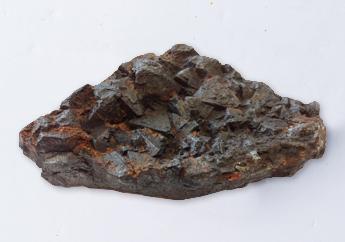Missouri Geological Survey Director: Carey Bridges, RG
Magnetite is one of several prominent iron oxide minerals found in Missouri. These minerals are composed of the elements iron and oxygen. Large magnetite deposits in Missouri are found in the southeast part of the state and are related to igneous rocks that are approximately 1.4 billion years old.

example of magnetite crystals from the
Iron Mountain Mine in St. Francois County.
Magnetite’s composition is Fe3O4, making it the richest of the iron oxide ore minerals. Magnetite, as is implied by its name, is magnetic. It will attract a magnet but does not act as a magnet itself. Naturally magnetized magnetite, called a lodestone, will act as a magnet, and was used for the first compasses. Another important iron oxide mineral found in Missouri is hematite, with a composition of Fe2O3. Hematite often looks similar to magnetite but is not magnetic and will be red when powdered, unlike magnetite, which makes a black-colored powder. Most magnetite in Missouri is very fine grained and massive in character.
Missouri has a long history of magnetite and hematite mining. The Iron Mountain Mine was first recorded in a land grant in 1797, with mining of the two minerals beginning in the 1830s. The mine operated continuously until 1966, with over 130 years of ore production. The mine site continues to produce crushed igneous rock for numerous industrial uses, making it the longest continually mined property in the United States. Other historic mining included magnetite veins on Shepherd Mountain (1815) and the Pilot Knob surface hematite mine (1835-1920s), both located in Iron County. More recent mining of magnetite occurred from 1964-2001 at the Pea Ridge Mine (Washington County) and from 1967 to 1980 at the Pilot Knob underground mine (Iron County).
Historical iron mines in Missouri strongly affected settlement and development of parts of southeast Missouri. The towns of Iron Mountain, Pilot Knob and Ironton were all settled by miners working the iron mines. The Iron Mountain and Pilot Knob surface mines led to construction of the St. Louis and Iron Mountain Railroad, completed in 1858. It eventually became the Missouri Pacific Railroad, one of the nation’s major rail systems.
Although no iron currently is being produced in Missouri, the state contains significant reserves of high quality magnetite ores. Some of this magnetite is what is known as high-quality, high-purity magnetite. While most associate iron with steel girders in buildings or car body frames, it may surprise many to know of the diverse uses for high-purity iron ores. These uses include water purification systems, “green” air emission catalysts, radiation shielding, coal desulfurization and densification of concrete for structures requiring extra strength, such as bridge pillars in rivers. Iron oxide minerals are very stable and nontoxic, and when powdered are used as pigments in everyday items as varied as coloring in decorative concrete to many cosmetic items, including powdered magnetite as a black pigment in mascara.
Visit the department’s Ed Clark Museum of Missouri Geology, where you will find magnetite on display.
Nothing in this document may be used to implement any enforcement action or levy any penalty unless promulgated by rule under chapter 536 or authorized by statute.
For more information
Geological Survey Program
Missouri Geological Survey
P.O. Box 250
Rolla, MO 65402-0250
United States
